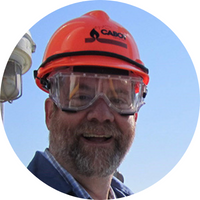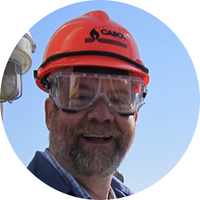
You spent 23 years with Dow, then left the company to join Cabot Corporation in Boston. What prompted the move?
The main driver was that I wanted to do something just for the fun of it. Dow has tremendous capabilities, great people, and a host of interesting problems. They taught me about making polymers, catalysts, monomers, cellulose ethers, pharmaceuticals, and bulk chemicals. I was near the top of the technology ladder there and had achieved good success in a competitive environment. The question I asked was “have I already done more than half of what I am ever going to do for Dow?” The answer was probably yes, and at 50 I was not eager to go slowly down the easy slide for the next 15 years.
It was also a chance to remedy mistakes. With such great projects and mentors, success at Dow was almost immediate for me. I came to believe that I could be “outside” of the system, hang out with the operators, and wear flowered shirts. After 20 years, the result was being inducted into a group of senior leaders that I had kept at arm’s length up to then. Starting anew at Cabot, I worked to be a collegial part of the leadership organization as fully as possible. Resolving that tension created peace of mind and a better opportunity to shape the future.
The point in the two companies’ histories was another factor. My personal motivator from beginning has been to develop working processes for new to the world materials - or at least radically new processes for existing materials. Someone once said that a bulk material firm like Dow makes flour and an additive firm like Cabot makes spices. Dow scaled up a series of new chemicals and plastics but often had a difficult time in the marketplace with them. This is largely due to the “Nylon Problem” below. Being in the smaller scale additive business gives Cabot an easier time to bring a new material to market. The playground is smaller, but it is a great playground.
Other factors include that Cabot is very capable with a great safety culture. For a late career transfer, they pay well enough to compensate for the three times higher cost of real estate. Located in the fabulous Boston technology and cultural hub, there is all kinds of outside consulting work to do with startups from the universities. The chances to teach are abundant. Midland, Michigan is a great place to raise a family, but it is remote. Once we had an empty nest, we wanted to be near family in the Boston area.
What did you learn at Dow that has helped you execute your responsibilities at Cabot?
I learned the principles and practice of process development from some of the greatest practitioners in the history of the world. Dow is a huge playground for scientists and engineers. I landed in a corporate R&D group for oddballs and was able to work anywhere across this playground. Within each of the individual businesses were very challenging problems and senior technical people eager to teach the trade to a motivated youngster.
Dow has a system for everything, including developing processes. From route selection, process concept development, process definition to implementation and startup, they have a ‘process development process’ that almost always produces an effective, economical, and safe production process. Especially for new materials, a systematic approach works well. This applies well to Cabot’s processes, by and large.
Most importantly, there were a lot of materials processes to develop. Process people develop their skills on the job by improving or developing processes and fixing their many mistakes. The pressure to make any new products in existing assets instead of building new ones is greater than in the 1980’s.
Based on your experience teaching at MIT and lecturing at other Boston area universities, how would you characterize the strengths and weaknesses of contemporary students?
These are great students. It’s a common pastime for the older generation to disparage the qualities of the younger generation. Maybe some of us see a lack of experience as a lack of ability, or we are simply threatened by their youth and energy. To me, each new set of colleagues has been better than the last in important ways. The current crop is excellent.
A big change is that many chemical engineering students today plan to go into fields unrelated to their training. Medicine, business entrepreneurship and international business are some of the destinations. My cadre was almost all bound for the petrochemical industry in the area.
My BS was at LSU and most of my professors were retired from industry. This was the perfect experience for an engineer. A few professors in the Boston area are also industry veterans, but the lack of chemical industry in the area, the need to be part of the system to raise funding and the high cost of living make this less common than in Baton Rouge.
A shining positive aspect of this generation of students is the cultural diversity. The sciences have been diverse for a long time, but globalization has accelerated this transition. From this comes amazing synergies. Someone once said that Americans believe what they think, Germans believe what they plan, and Asians believe what they see. While this stereotype is flawed, it illustrates the power of teams made of diverse cultural perspectives.
Cabot is especially great in this way since Boston is such an international magnet for technology people. I am often the only American in the group. We are located in 22 countries. Engineers have bulky toys, so we get to travel and solve problems in exotic places while immersed in the culture there. Solving problems alongside a different culture is an enlightening experience for Americans and those we visit. I recall a Japanese colleague asking “Siddall-san, why did you do that experiment?” I said “I wanted to see what would happen.” I am not sure he ever got over that!
It is still a journey, though. There is still a considerable imbalance in gender on the engineering side, though the balance is much more even on the scientist and organizational leadership sides. There looks to be a glass ceiling at the very top levels still.
It is conjecture, but I assert that two changes in society have made the current students more capable than my cohort: smaller families and video games. “Say what?” you ask…
I am a baby boomer, the youngest of five. Layer upon layer of undersecretaries were between my parents and me. We as kids spent our time with other kids, not with adults. The current generation has few siblings and the “kid’s culture” has vanished to a great degree. We lost something there, but the positive is that the students are more comfortable dealing with older adults. This opens a lot of doors for them in the workplace.
Video games have a lot of negatives in terms of social skills and physical health, but some of them do teach strategic thinking. Looking a step or two ahead is key to success in those games and in the chemical industry. I had better save some blasting stars when I get this bad guy because the next level is going to be tougher. This process is great, but the waste is going to be difficult to treat.
The students are well prepared, but the opportunities to learn on the job are more limited. We often hear that the world is going faster and faster. This is not generally true in the chemical industry. The pace of introduction of new products and the overall speed of the industry is slowing. There are some wonderful bright spots, below.
Is the ‘spirit of science’ different today?
The spirit of science is different today. On the plus side, society is more sophisticated in general. We are better informed and at ease with cutting edge technologies. Technology has made much of the world a wealthier place and it is very widely deployed. On the minus side, we of the Apollo era know of a time when science was a more powerful social force, universally respected. Today, there are more misgiving about scientists and other experts, partly because we have seen that technology can cause problems as well as solve them.
Mechanical skills are a challenge for the current generation of students. My cohort worked on our own cars, built our own computers, and could fix almost anything. Today’s students did not have that opportunity and some struggle with even basic physical activities. These mechanical skills can be taught, but the biggest challenge is keeping the young people alive while they make the mistakes we made as teenagers. It’s not a huge deal and makes us older folks feel useful sometimes. To be fair, some of our young mechanical engineers have fabulous mastery of hand skills.
Another reality is compensation. While these and all STEM jobs are rewarded well, real wage growth has not kept pace. My first home was wonderful and cost only about 2.3 times my starting salary at Dow. Dow even co-signed for a down payment loan, so I bought a house after working for nine months with zero personal equity.
In Boston, a house is easily 5 to 7 times a starting salary and down payments are huge. Between that and the burden of student debt, today’s new employees are less wealthy than my cohort. Moves like a home purchase or having kids are more impactful and likely to be postponed today. This delay has a secondary effect. My kids were out of the house and we had no debt by the time I was 50, so our post-children savings period has had a longer run than will be the case for many of today’s young professionals. You must not carry debt into retirement because you then service it from savings.
Having spent time working in industry and teaching, if you were in your early 20s again, which career path would you take: Industry or academia?
This is a difficult question. Universities are more free and industry is more constrained. However, academics face a shrinking pool of funding and spend a lot of time dealing with money. Ironically, we usually have plenty of money to spend in industry. It is like water – we try not to spill it, but we take what we need. Our salaries are costly and depriving us of resources would be bad business. We also have power in industry. Not so much over people, but over how resources are deployed. We build complex and huge machines that reliably do what we had only in our imagination at one point. This power is fabulous and generally healthy.
What we in industry give up is a big one: self-determination. We work on what we are told to work on. How we go about it is up to us, usually. For some, this would be too high a price to pay. For me, it is the problems we solve and people we solve them with that matter more than the actual target. Everything we makes goes to the landfill someday – the question is how much good it did on the way there.
A younger professional is motivated by drivers including purpose, growth, adventure, and the resources to enjoy the other parts of their life. An older professional is mostly motivated by legacy and adventure. We want to leave something good behind and have fun doing it.
Academics may have a better opportunity for legacy. Industry people get the adventure. We get to go all over the world and change technologies and roles often, while professors can usually only get funded in their area of expertise. Only a few can reinvent themselves. We do this frequently in industry because we must. Projects are like climbing a tree. No need to do it twice.
Some say that scientists create knowledge and that engineers use knowledge. I started my college career in chemistry like my father and brother, but moved to chemical engineering midway through. This was right for me. As much as I might wish otherwise, I am not especially driven by an interest in science. I just want to make something good happen and will use whatever resources I can get to accomplish it. I’d make the case that this is the fundamental career question: Do you want to create knowledge or use knowledge? From there, the choice of academia or industry is easy. There is a midway point where they make devices and systems in universities. That may be a happy medium.
In later years, the teaching is delightful since we have experience to share. When I taught in this area, it was great. I am happy to teach the students how to slay dragons, but I am not ready to be done with slaying them myself. It’s just too much fun. Though sometimes these dragons have other ideas. As we say in industry about troubleshooting: “Sometimes the trouble shoots back.”
On which one of the following would you like to see undergraduate chemistry programs focus more attention: Sustainability? Safety? Communicating one’s science? Careers in industry? Something else?
Communication skills are the primary factor in career success. Could you explain your work to your aunt or your dentist? Those who grew up speaking other languages are not at that much of a disadvantage. If you communicate well in your native language, you will succeed in English with time. You always need to be ready to communicate your work to anyone on a moment’s notice.
Chemical engineering: We engineers take about ten chemistry courses and six or so chemistry labs and then more in grad school. Chemists need to meet us as partners partway with some chemical engineering knowledge in an overview course. This is basically physical chemistry thinking with some equipment concepts thrown in. Pumps, leaks, and ambition are the scourges of chemical engineering.
We are just crazy about safety. Since we accumulate so much potential energy, mistakes can be very impactful. Safety is our license to operate and we have destroyed entire communities. Joke about money, the boss’s toupee, and why anyone would buy this stuff, but safety is sacred.
In our careers, we succeed by creating something that was not there before. It is the ability to synthesize novel approaches that we often desire. Organic chemistry is a good area where you learn these skills… “starting with alcohols of four carbons or less and any needed inorganic reagents…” More of that synthesis mindset will help a lot.
Someone told me that product and process development is applied analytical chemistry. You will depend on the analysts to guide you through the maze of your role. Know the techniques, how they are applied, and how to interpret the results.
Soft skills of compassion, courage, watching other’s feelings and respect are critical to success. Almost everyone has plenty of smarts and training. My recipe for success that I got from my dad is simple: “Give the boss something better than they were expecting and be nice about it.”
A note about recruiting: We hire many people and it may be good to see the hiring manager’s perspective. A great analogy is buying a pair of shoes. There are three issues:
- Do I need new shoes?
- Are these good shoes?
- Do these shoes fit?
It’s not just about how good the shoes are. If you can try to see it that way, the process may make more sense to you. Being as versatile as you can be will help your chances. Computational-only thesis projects are to be avoided. You can succeed with one but it will cost you some years.
Talk about the metaphorical “one that got away”. Is there a project that eluded you? Why? And if you could return to it, what you do differently now?
Many of them got away and usually for the same reason - the “Nylon Problem”.
The issue we face in mature industries like the chemical industry is that we are capability rich and target poor. There is a material solution for almost all large applications. We can make almost any molecule you can draw – for a price. Please don’t misunderstand - it is certainly not time to close the patent office! What we need is new applications for materials and not so much new materials for existing applications.
Because of this maturity, the opportunities to make truly new materials are less at this point in history. There is a simple reason for this, and it is due, to all things, a simple dimensional analysis or the Square-Cube law. This makes large scale processes win every time and in turn limits materials innovation.
Mark Jones demonstrates the power of scale with Origami. It is usually far cheaper to make a unit of material on a large scale. This is because you buy plant assets by the weight of the materials of construction but use them by the volume of the equipment that you build.
Equipment that can process 100 times as much material usually is only around 1000.6 or 16 times as much cost to build. A new material is made on a small scale and cannot compete with a large-scale incumbent on price. With each advance in materials, it is more difficult for the next generation of materials to be enough more valuable to overcome this cost disadvantage. I have worked on materials that are superior in many ways to what you use today, but they cannot grow commercially for this reason. It’s not a technical problem as much as a business problem. And today’s materials are mostly “good enough” When’s the last time a plastic object unexpectedly let you down? Globalization makes this even more daunting since production of existing materials moves to low cost places, making them even harder to displace.
Before we despair, this issue has been known since at least my grandfather’s time. When my dad was at DuPont, they called it “the Nylon Problem”. DuPont grew rapidly when they introduced polyamides like Nylon 6,6 largely to replace silk in hosiery. After that, it was very difficult to displace Nylon because it enjoyed such economies of scale.
Only products like polyolefins with much cheaper raw materials could do it, often with poorer performance. Once you get to very low cost raw materials, the game is nearly over. The Nylon Problem will eventually assail any line of products, leaving our industry with these basic options to commercialize a new material:
A – Make a new material essential to support an entirely new application that is growing either due to the innate value of the final product system or due to a mandate – Water-based paint, Ink Jet pigments, lithium ion battery materials, CO2 sequestration system consumables, for example.
B – Find niche applications for the material that can command the price – “engineer cowlings for the hypersonic transport”. Two of them each are on all three planes.
C – Sell at a loss into mainstream applications until there are enough sales to justify a world-scale plant.
D – “Build big and they will come” – gamble that the market will be there and build an economical world scale unit right away and hope the stuff sells.
The Nylon Problem is part of why there is so much pressure to use existing assets to make new products – the economy of scale is already there with little risk. This is a delightful area to work in. The risk is low enough that we can gamble frequently and do not need to win every time. Of course, high performance materials are all difficult to make. Few assets are flexible enough to make anything other than a new grade of what they were designed to make. New polyolefin synthesis catalysts have been very successful for this reason – a little bit of a new catalyst makes a lot of a differentiated polymer with little added cost.
It’s 2040. What is providing humanity with its greatest challenge? Access to food? Water? Energy? Clean air? Something else?
Society has interim problems and permanent problems. Interim solutions work for interim problems. Water, energy, and food issues may be very important at times, but we will prevail if we are smart and lucky.
One of the permanent problems that we techies face is capabilities vs. ethics. We can do almost anything we can imagine. But should we? Will we cause more problems that we solve? Can we do this sustainably?
While it is mature, our industry has limitless opportunities. Many opportunities are tied to the growth of the global middle class, while others are responses to new interim problems such as energy storage, lower environmental impact, and overall quality of life. Three that stand out are:
- Esthetic materials: Many of today’s materials do their functions well but are not esthetically pleasing. As the middle class grows, they will demand materials and devices that not only function but are a pleasure to experience. This is part of the enduring appeal of old materials like porcelain, metal, wood, and cotton. High thermal diffusivity, a depth in the appearance, a “natural” feel, and hard/soft contrasts are examples of esthetics that will grow in demand. We can certainly develop materials that will excel there.
- Developing world: There are fantastic opportunities to supply the developing world with materials to make their lives safer and easier. The growth of the middle class is slow in the developed world, but not in the developing world. With time, those new middle-class people will desire products that are tailored to their culture, not that of today’s first world. Good examples are personal care and laundry products which vary significantly by region.
- Human health: As long as people keep dying, there will be a demand for new drugs and other medical devices and therapies. There is a still a “Nylon Problem” with drugs in that there is a pill for most common conditions and a new pill faces huge development costs. The manufacturing costs themselves are still a small portion of the total drug cost. It requires a huge scale – not in the manufacturing process but in the entire drug development process. Vaccines and antibiotics are administered at low rates and are not profitable enough to develop. A safe anti-obesity drug will dwarf all of these together.
Of course, high quality air and water will increasingly be demanded. Middle-class people with money and small families will not tolerate environmental stress and will pay to resolve it. We know how to do this. It is mostly a matter of deploying known technology.
There is a lot of fun to be had in chasing the “holy grails”, such as the silicon battery anode, direct hydrogen peroxide, methane coupling, and of course, the plastic beer bottle (Ever seen one? Ever wonder why not?) While the playing field has changed, it is a great game for the foreseeable future.
How will scientific meetings need to evolve to remain relevant in the post COVID-19 era?
Eventually it will be safe to meet in person again. We are likely to choose to do that less often. Conferences of all kinds are changed forever. The true power of connectivity by the internet has instantly become apparent. It saves so much energy, CO2, time, money, and hassle. We also see how the tools we have today fall short of the first-person experience. With so much value created by remote connectivity, we can expect tremendous innovation in this area. It may never quite equal being there, but it will get very close with time.
Being so inexpensive, it will level the playing field, letting lesser known institutions or countries have a place at any table because of their merits, not their resources. COVID-19 has produced a moment in history that we in the middle of it will not fully appreciate for some time.
What technical challenge addressed during your career brought the most satisfaction and why?
Syndiotactic polystyrene (sPS) was certainly the most satisfying challenge. It was a joint development venture between the inventor Idemitsu and Dow, who was called to help develop the process. It is a high heat thermoplastic with a very low costs basis. The magic is in the catalyst system that directs the polymer structure. Besides the low raw materials styrene cost, we were able to get a huge subsidy for plant cost as part of our work to rejuvenate a large communist era site in Central Germany (Schopau). This let us circumvent the Nylon Problem by going big for the first build and achieving immediate economies of scale.
So many new materials owe their great properties to a feature that also makes them practically impossible to make. We who face this fact love the irony. The high 270C melting point of sPS is because it is stereoregular and crystallizes rapidly. But of course, it crystallizes in the reactor as well! The game is on from there.
Many thermoplastics make a “goo” during reaction that you push out with the feed, but this stuff solidifies. It won’t come out of a typical polymerizer. To reduce catalyst costs, we ran it neat, with no diluents. This gives an adiabatic temperature rise of around 400K, but we must hold the temperature below about 80C or the quality suffers. The desired powder reactor product has poor heat transfer properties and partially converted monomer fouls the equipment everywhere. Wonderful. We tried out nine divergent designs for reactor systems before we settled on a variant of this one.
A less tangible but more important feature of difficult projects like this is that they attract great people and bring out the best in the organization. Both companies’ pride was on the line in the joint project with Idemitsu. Everyone, from the business leaders to the chemists, materials scientists, engineers, analytical scientists, tradesmen, operators and maintenance people were the best we had in both companies. The limiting reagent in any project is not skill, but energy. That project had so much of that.
Even with such a high melting point, limited oxidative stability and inadequate impact strength prevented wide adoption of the material. While regrettable, we were all doing other fun projects by the time this became understood. This is another irony of our business. Commercial success or commercial failure are not all that different to us developers. We are off chasing another dragon by then anyway. We prefer success, of course. But mostly because it brings energy to the next new project.
You get to put four people on your Mt. Rushmore for scientists. Who are they?
The great scientists and engineers are ordinary people who are driven, talented, hardworking, and lucky. A monument that symbolizes their work makes more sense to me than one that depicts their physical being. Artistic symbolism of the works of Newton, Mendeleev, Jenner, and Copernicus could be good choices for this. There are so many more that a medium less massive than stone may a good choice. What we will do when their great ideas are hopefully replaced by even greater better ones is a great question. We who work in this field must always be ready for our cherished axioms to be displaced.
The chemical industry is a fine use of the human mind. We solve problems that society values and it matters a great deal how well we solve them. It has undergone a great deal of change through globalization and the maturity of our products. There are still limitless opportunities to impact the world for the better in the industry.

Jon Siddall is a process Fellow at Cabot Corporation, a specialty materials company headquartered in Boston. His expertise is in process development and is the lead engineer in that capability at Cabot. His bachelor’s degree is in chemical engineering from LSU. His doctorate in chemical engineering from Purdue addressed the mechanism of methanation of CO over cobalt using steady state isotope tracer methods. Before Cabot he was a process development engineer at Dow Chemical for 23 years. There he and his teams developed processes for a wide range of new materials as well for established products. Jon has taught chemical engineering at MIT and lectures at schools in the Boston area.
This article has been edited for length and clarity. The opinions expressed in this article are the author's own and do not necessarily reflect the view of their employer or the American Chemical Society.
Copyright 2020 American Chemical Society (All Rights Reserved)










